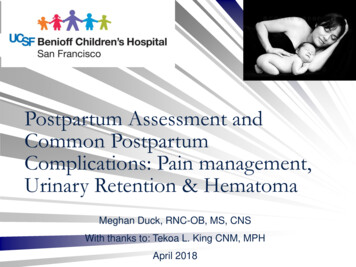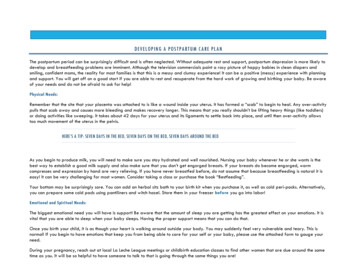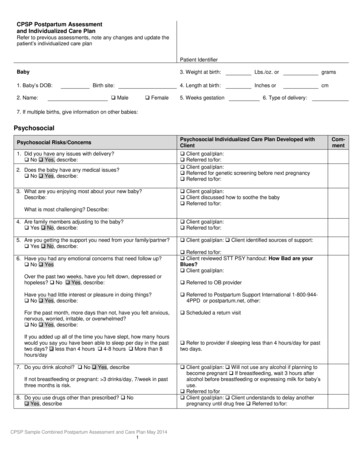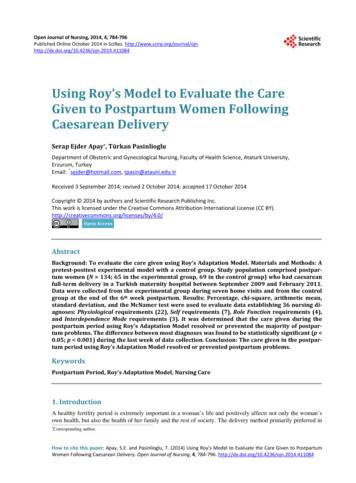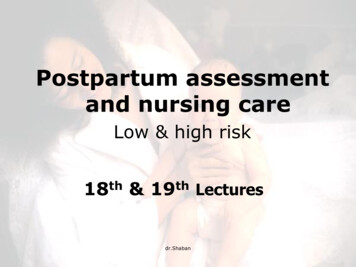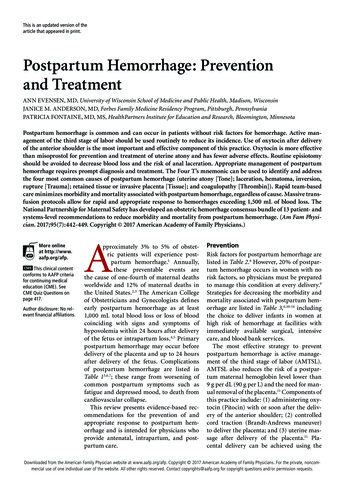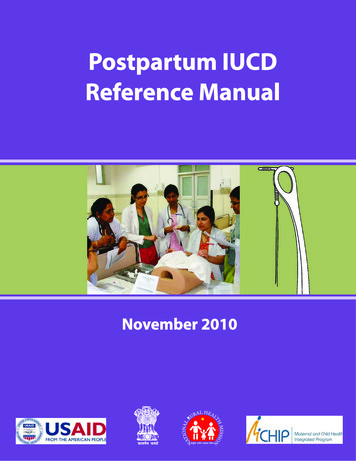
Transcription
Postpartum IUCDReference ManualNovember 2010
Postpartum IUCDReference ManualNovember, 2010
Ministry of Health & Family WelfareGovernment of India,Nirman Bhawan, New Delhi-110011Any part of this document may be reproduced and excerpts from it may be quoted withoutpermission provided the material is distributed free of cost and the source is acknowledged.First Published, November 2010This manual was developed through technical assistance from USAID under the ACCESS-FPprogram and printed with support from the Bill & Melinda Gates Foundation. The viewsexpressed herein do not necessarily reflect the official policy or position of the Bill & MelindaGates Foundation.
TABLE OF CONTENTSChapter 1Postpartum Family Planning ------------------1Chapter 2Postpartum IUCD ------------------------------5Chapter 3Postpartum Family Planning Counseling ----8Chapter 4Infection Prevention -------------------------- 11Chapter 5Medical Eligibility Criteria and Client Assessment ----------------------------------------- 16Chapter 6Clinical Technique for Insertion of the Immediate Postpartum IUCD ----------------- 19Chapter 7Management of Potential Problems -------- 29Chapter 8Follow-Up Care -------------------------------- 34Chapter 9Quality Assurance for Postpartum IUCD services ------------------------------------------ 36Annexure A Client Messages About Basic Information of IUCD --------------------------------------- 39Annexure B Postpartum IUCD Counseling Checklist - 41Annexure C Job-Aid for Postpartum Family Planning Counseling and Time for Initiation ofContraceptives --------------------------------- 44Annexure D Steps in Processing Instruments and Other Items used in PPIUCD Services ---------- 47Annexure E Additional Information on Chemicals Used in Infection Prevention Processes -------- 48Annexure F Medical Eligibility Criteria (MEC) for IUCD Insertion ---------------------------------- 52Annexure G Job-Aid for Immediate PPIUCD Pre-Insertion Screening of Client --------------------- 54Annexure H Checklist for Clinical Skills Postplacental Insertion of the IUCD Using Forceps ----- 55Annexure I Skills Checklist for Immediate Postpartum Insertion of the IUCD ---------------------- 58Annexure J Checklist for Clinical Skills Intracaesarean Insertion of the IUCD ---------------------- 60Annexure K Job-Aid for Post Placental IUCD Insertion Technique ------------------------------------ 62Annexure L Protocol for Missing Strings ----------------- 63Annexure M Supplies and Equipment for Postpartum IUCD Clinical Services ----------------------- 64Annexure N Performance Standards for PPIUCD Services ----------------------------------------------- 66Annexure O Postpartum IUCD Insertion and Follow-up Register Formats --------------------------- 68Annexure P Monthly PPFP/PPIUCD Services Report - ------------ 72
ABBREVIATIONSAIDSAcquired Immuno Deficiency SyndromeAMTSLActive Management of Third Stage of LaborANCAntenatal careBPMBeats per MinuteCBCComplete Blood CountCuTCopper TDMPADepot Medroxy Progesterone AcetateFPFamily PlanningHSPHealthy Spacing of PregnancyIUCDIntra Uterine Contraceptive DeviceHIVHuman Immunodeficiency VirusHLDHigh Level DisinfectionIPInfection PreventionLAMLactational Amenorrhea MethodMCHMaternal and Child HealthMECMedical Eligibility CriteriaNSVNo-Scalpel VasectomyOTOperation TheatrePIDPelvic Inflammatory DiseasePNCPostnatal CarePOPProgestin-Only-PillsPPFPPostpartum Family PlanningPPIUCDPostpartum Intra Uterine Contraceptive DeviceROMRupture of MembranesSTIsSexually Transmitted InfectionsWHOWorld Health Organization
CHAPTER 1POSTPARTUM FAMILY PLANNINGBackgroundPostpartum period is one of the critical times when both woman and newborn need a special and integratedpackage of health services as morbidity and mortality rates are quite high during this period and also thewomen are vulnerable to unintended pregnancy. Studies show that pregnancies taking place within 24months of a previous birth have a higher risk of adverse outcomes like abortions, premature labor,postpartum hemorrhage, low birth weight babies, fetal loss and maternal death.Postpartum PeriodThe postpartum period has traditionally been understood as the first six weeks after the birth of a child, asby then, the woman’s body has largely returned to its pre-pregnancy state. However there is a need to focuson the “extended postpartum period;” i.e., the first 12 months after birth.Programmatically it is convenient to further define the time periods as the interventions and issues varyduring the period of first 6 weeks and beyond up to one year after childbirth.1. Immediate Postpartum - Postplacental and within 48 hours after deliveryThe immediate postpartum period is an ideal time to educate and counsel a woman on exclusivebreastfeeding as a contraceptive method. Counseling on future fertility, birth spacing or limitingintentions, and provision of appropriate family planning methods like IUCD, sterilization should also beprovided in this period.2. Early Postpartum - up to 7daysPostpartum Sterilization can be performed within this time period. Messages on Lactational AmenorrheaMethod (LAM) should be reinforced.3. Extended Postpartum - 6 weeks to 1 yearSpacing methods like IUCD and other methods as per the Medical Eligibility Criteria (MEC) can beprovided. Laparoscopic/minilap tubal ligation can also be performed during this period.Women are highly motivated and receptive to accept Family Planning (FP) methods during the postpartumperiod. Demographic and Health Survey show that 40 percent of women in the first year postpartum intendto use a family planning (FP) method but are not doing so.Institutional deliveries have increased significantly all across the country, thereby creating opportunities forproviding quality postpartum family planning services. The postpartum services need to be strengthened byintegrating maternal and child health (MCH) and FP services at each level of health facility from the districthospital to the sub-centre.Postpartum IUCD Reference Manual1
Rationale for Postpartum Family Planning1. Maternal and Child Health A baby born after a short birth interval has increased chances of:o being born pre-termo being small for gestational ageo death during newborn period or childhoodA woman who becomes pregnant too quickly following a previous birth or spontaneous or induced abortionfaces higher risks of:o anaemiao abortiono premature rupture of membraneso maternal mortalityAdolescent reproductive healthPregnancy during adolescence poses a higher risk of adverse outcome for the mother and the babyand it is important that she is counseled to delay the childbirthoEarly pregnancy at age less than 18 years is associated with increased risk of health complicationsfor mothers and newborns compared to women aged 20 to 24 years old.oAdolescent mothers aged 15-19 years are twice as likely to die during pregnancy or childbirth asthose over 20; girls below the age of 15 are five times more likely to die.2. Unmet need for birth spacing In India, 65% of women in the first year postpartum havean unmet need for family planning, as shown in Figure 1.1. Only 26% of women are using any method of familyplanning during the first year postpartum. 8% of the women desire to have another child within thenext 2 years after giving birth and are vulnerable to the risksof early pregnancy.3. Return of fertilityFigure 1.1: Unmet Need amongWomen in the First Year PostpartumUnmet Need among Women in theFirst Year PostpartumN 11,649Source: USAID/ACCESS. 2009. FamilyPlanning Needs during the ExtendedPostpartum Period in India Exclusive breastfeeding-While more than 55% ofwomen exclusively breastfeed their babies in the first three months following delivery, this rate drops tonearly zero by one year as shown in Figure 1.2 and this exposes them to risk of pregnancy. Partially breastfeeding or not breastfeeding -Women may resume menses within 4-6 weeks ofdelivery and first ovulation may occur as early as 45 days postpartum thereby increasing the risk ofpregnancy soon after childbirth. Lactational Amenorrhea–Some women may experience amenorrhoea during breast feeding even ifthey are not practicing exclusive breast feeding or do not satisfy the three criteria of LactationalAmenorrhea Method (LAM). There is a probability that ovulation may occur before the return ofPostpartum IUCD Reference Manual2
menstruation. Therefore, amenorrhea after child birth is an unreliable indicator that a woman isprotected against pregnancy.Figure 1.2 Factors Related to Return to Fertility and Risk of Pregnancy in the First Year after Birth100%Percent of Postpartum Women90%80%70%Sexually active60%50%Return to 7-910-12Postpartum MonthsSource: USAID/ACCESS. 2009. Family Planning Needs during the Extended Postpartum Period in AsiaReturn to sexual activity-As in figure 1.2,during the first year postpartum, approximately 40% women returnto sexual activity within the first three months and by 10-12 months postpartum 90% have resumed sexualactivity which exposes the woman to risk of having an unintended pregnancy. The period after three months, when exclusive breastfeeding is falling, menses is returning and couplesresume sexual activity, can be considered a period of high–yet unperceived–risk of an unintendedpregnancy. Couples will not necessarily see themselves at risk of pregnancy at this time and will notfully recognize the need for family planning. Following an abortion, a woman’s fertility returns within 10–11 days. Women who haveexperienced a spontaneous or induced abortion should begin use of a contraceptive method within48 hours to prevent an unintended pregnancy.Healthy Spacing of Pregnancy (HSP)Approximately 27% of births in India occur in less than 24 months after a previous birth. Another 34% ofbirths occur between 24 and 35 months. 61% of births in India occur at intervals that are shorter than therecommended birth-to-birth interval of approximately 36 months. The birth-to-pregnancy interval is the time period between a live birth and the start of the nextpregnancy. After a live birth, a woman should wait at least 24 months (but not more than five years)before attempting the next pregnancy.Postpartum IUCD Reference Manual3
After a spontaneous or induced abortion, a woman should wait at least 6 months before attemptingthe next pregnancy. Adolescents should delay first pregnancy until the age 20 yearsElements of Postpartum Family Planning Helping couples understand their risk of unplanned pregnancy and ensuring high quality postpartumfamily planning services.Information about optimal birth spacing—including the benefits of spacing births—should be providedto the woman /couple at various points of contact like in family planning clinics; antenatal clinics; laborwards/rooms; postpartum and postnatal care facilities; immunization and child health services; and anyservice or facility where mothers and children receive routine health care.Linkage of maternal and newborn health and family planning services at all levels.Postpartum IUCD Reference Manual4
CHAPTER 2POSTPARTUM IUCDBackgroundIntrauterine contraceptive devices (IUCDs) have been used by women in India for decades for spacingpregnancies. In some of the health facilities, it has also been provided to women in the immediatepostpartum period. Returning to health facilities for postpartum services after delivery is challenging tomothers who have competing demands.Taking advantage of the immediate postpartum period for counseling on family planning and IUCDinsertion, overcomes multiple barriers to service provision. The increased institutional deliveries are theopportunity to provide women easy access to immediate PPIUCD services.PolicyThe CuT-380A is approved for immediate postpartum insertion as a method of contraception.The PPIUCD must only be placed after the woman is counseled and gives informed consent. Counselingshould take place in the antenatal period, in early labor or immediately postpartum. Counseling forinformed consent should not take place during the active phase of labor.The PPIUCD can be placed immediately following delivery of the placenta, during cesarean section orwithin 48 hours following childbirth.The IUCD must be inserted only by a service provider who has been trained to competency in ImmediatePPIUCD service provision according to national standards.PPIUCD insertion must be done in a healthcare facility that provides delivery services and has acceptablestandards of infection prevention.StandardsThe following standards of care must be maintained.1. Woman must be counseled regarding advantages, limitations, effectiveness, side effects and problemsrelated to IUCD.2. The provider must explain the procedure for insertion and/or removal of the immediate PPIUCD.3. Woman must be screened for clinical situations as per WHO Medical Eligibility Criteria (MEC).Screening should take place in the antenatal period, as well as immediately prior to insertion, immediatepostpartum.4. The woman must be counseled and offered another suitable postpartum family planning method if herclinical situation does not allow for insertion of the immediate PPIUCD.5. The provider must insert the IUCD by following all recommended clinical and infection preventionmeasures for successful insertion.Postpartum IUCD Reference Manual5
6. Insertion must be done using a long instrument, such as a placental forceps, to ensure that the IUCD isplaced at the fundus.7. The provider must maintain records regarding PPIUCD insertions and services as per protocol.8. Woman must be followed up by a provider oriented to PPIUCD services.Timing of IUCD InsertionThe usual timings are: Immediate Postpartum:o Postplacental: Insertion within 10 minutes after expulsion of the placenta following a vaginaldelivery on the same delivery table.o Intracesarean: Insertion that takes place during a cesarean delivery, after removal of the placenta andbefore closure of the uterine incision.o Within 48 hours after delivery: Insertion within 48 hours of delivery and prior to discharge fromthe postpartum ward. Postabortion: Insertion following an abortion, if there is no infection, bleeding or any othercontraindications. Extended Postpartum/Interval: Insertion any time after 6 weeks postpartum.The IUCD should NOT be inserted from 48 hours to 6 weeks following deliverybecause there is an increased risk of infection and expulsion.Overview of IUCDsThere are 2 types of IUCDs available in India – Copper-bearing IUCDs, made of a small inert plastic frame covered with copper sleeves and/or copper wire Progestin-releasing IUCDs which continuously release a small amount of levonorgestrel.Among the copper-bearing IUCDs, the CuT-380A is available in the government program and it is used forimmediate postpartum insertion. Cu-375 (popular commercial name Multi Load) has been approved for use inthe private sector, with planned introduction into the government program (Refer IUCD Reference Manual,Ministry of Health and Family Welfare, Government of India 2006 for details).Mode of ActionThe IUCD interferes with the ability of sperm to survive and to ascend the fallopian tubes wherefertilization occurs. It alters or inhibits sperm migration, ovum transport and fertilization. It stimulates asterile foreign body reaction in endometrium potentiated by copper.Postpartum IUCD Reference Manual6
Effectiveness The CuT-380A is a highly effective ( 99% effective). There are 0.6 to 0.8 pregnancies per 100 womenin first year of use. The CuT-380A is effective for 10 years of continuous use. It can, however, be used for whatever timeperiod the woman wants, up to 10 years.AdvantagesThe specific advantages of an IUCD placed in the immediate postpartum period include:Advantages for the woman: Convenience; saves time and additional visit. Safe because it is certain that she is not pregnant at the time of insertion. High motivation (woman and family) for a reliable birth spacing method. Has no risk of uterine perforation because of the thick wall of the uterus. Reduced perception of initial side effects (bleeding and cramping). Reduced chance of heavy bleeding, especially among lactational amenorrhea method (LAM) users, sincethey are experiencing amenorrhea. No effect on amount or quality of breast milk. The woman has an effective method for contraception before discharge from hospital.Advantages for the service provider or the service delivery site: Certainty that the woman is not pregnant. Saves time as performed on the same delivery table for postplacental/intracesarean insertions. Additionalevaluations and separate clinical procedure is not required. Need for minimal additional instruments, supplies and equipment. Convenience for clinical staff; helps relieve overcrowded outpatient facilities thus allowing more womento be served.LimitationsThe specific limitations of an IUCD placed in the immediate postpartum period include: Increased risk of spontaneous expulsion. The skilled clinicians with right technique of insertion areassociated with lower expulsion rates. Perforation of the uterus while placing a PPIUCD immediately after delivery of placenta or duringcesarean section or during the first 48 hours postpartum is unlikely because of the thickness of theuterine wall in the postpartum period. No such cases are reported in the literature. The other limitations of the immediate PPIUCD are the same as the interval IUCD.Postpartum IUCD Reference Manual7
CHAPTER 3POSTPARTUM FAMILY PLANNING COUNSELINGBackgroundCounseling is an ongoing two-way communication process which enables the client to make an informedchoice of an appropriate contraceptive method. Counseling for PPIUCD placement should take placeduring regular antenatal visits. A system should be established to determine if women who attend ANCclinic have been counseled and have chosen a postpartum FP method. This is essential so that delivery roomstaff can be alerted regarding women who have chosen the PPIUCD so that preparations can be made toprovide the method immediately following delivery of the placenta.Immediate Postpartum IUCD counseling occurs in various stages:General health education, often group-based, is about immediate postpartum family planning methods andoptions. Stress on importance of initiating a family planning method soon after childbirth, spontaneous orinduced abortion.Individual counseling about immediate postpartum methods where a woman/couple considers and makes aninformed choice for a method that is well suited to her/their individual needs and circumstances in thepostpartum period.Method specific counseling about the immediate PPIUCD, for those women who choose IUCD forpostpartum insertion. She should be given information regarding advantages, limitations and side effectsabout the method. Refer Annexure A and B for details.Follow-up counseling for woman who has had the IUCD inserted immediate postpartum to help themeffectively use the IUCD.Counseling should be done with the woman, and if she prefers, with her husband and/ormother-in-law.Timing of Counseling for Immediate PPIUCD1. During antenatal visits: Women should be ideally counseled in the antenatal period for immediate PPIUCD insertion. Theprovider may use the Job-aid for counseling (Annexure C) to address the woman’s and her family’sconcerns and clarify their doubts.A woman’s choice of Family Planning method should be noted clearly onher antenatal card or record. This stamp or specific notation in the ANCrecord (figure 3.1) will enable the delivery room staff, to be prepared forproviding the method immediately following delivery of the placenta. Fig 3.1 Prototype of Stampto be put on ANC CardThe labor room staff should check the ANC card for this informationwhen the woman presents for delivery.Postpartum IUCD Reference Manual8
2. During admission:If not counseled during antenatal period, the woman has to be given information about postpartumfamily planning including PPIUCD as per her need. Those who express interest in the immediatePPIUCD should be provided specific information, as outlined in Annexure A.3. During early labor:If a woman presents in early labor (she is relatively comfortable, with infrequent contractions, and ableto concentrate on the information being provided), she can be counseled for an immediate PPIUCD.4. On the first day of postpartum period:For woman who could not be counseled prior to delivery, she can receive counseling on the firstpostpartum day.5. Prior to scheduled cesarean section:Woman who arrives to the hospital for a scheduled cesarean section, can be counseled prior to theoperation about Intra-cesarean IUCD insertion.A woman should NOT be counseled for the first time about immediate PPIUCD duringactive labor as she may not be able to make an informed choice due to stress of labor.Post Insertion CounselingFollowing insertion of the IUCD, the provider who has done the insertion should reinforce the key messagesrelated to PPIUCD and inform the woman regarding follow-up visits. A follow up card providing all relevantinstructions may be given to her on discharge from the facility.Points to be stressed are importance of exclusive breastfeeding and assurance that the IUCD does not affectbreastfeeding.To return after six weeks for IUCD/Postnatal Care (PNC)/newborn check-up.To come back any time if she has any concern or experiences any warning sign or if the IUCD is expelled.Follow-Up Care and CounselingFollow-up care of the immediate PPIUCD acceptor is very important to ensure client satisfaction andcontinuation of the accepted method. It allows the provider to know if the counseling messages were clearlyunderstood by the woman and also to confirm that the IUCD is in place. A woman should come for checkup at 6 weeks and thereafter as and when necessary. If the woman lives far from the facility where theimmediate PPIUCD was inserted, ANM/ASHAs, can provide appropriate follow-up counseling.During the follow-up visit: Ask the woman if she has any complaints.Postpartum IUCD Reference Manual9
Ask if she feels that the IUCD has spontaneously expelled. Do a clinical assessment for anaemia if she complains of excessive or prolonged bleeding. Perform a speculum examination on the first visit to assess if the IUCD strings have descended into thevagina. Thereafter, perform a pelvic examination only if necessary. If the woman does not have any concerns or complaints, she need not have additional follow-up solelyrelated to the IUCD. Ensure that the woman knows that she can come any time if there is a problem. If large numbers of women are not returning for follow-up to the site where the IUCD was inserted,consider following-up those women by community health workers through their out-reach services.While counseling clients, the provider may use Annexure B and C as Counseling Guide.Key Messages during Family Planning Importance of initiating a family planning method soon after childbirth, spontaneous or inducedabortion for maintaining healthy spacing of at least 3 years between two children. Fertility may return within four to six weeks for women who are not exclusively breastfeeding and asearly as 10-14 days after an abortion. Women who are practicing LAM should change to another family planning method before the baby issix months old.Postpartum IUCD Reference Manual10
CHAPTER 4INFECTION PREVENTIONBackgroundInfection prevention practices are an integral part of all clinical procedures to ensure the quality of services. It ismandatory to practice appropriate infection prevention procedures at all times with all clients to decrease therisk of transmissison of infection including HIV, Hepatitis B and Hepatitis C to the acceptor and protect thehealth workers and other clients from exposure to infection.The following basic infection prevention processes are to be ensured: Consistent implementation of Standard Universal Precautions (SUP). Use of aseptic/no-touch technique during every insertion procedure. Use of High Level Disinfection (HLD)/sterilized equipment for every procedure with appropriatedisposal of waste.Standard Universal Precautions of Infection Prevention1. Hand washing: Wash hands with soap and water or an appropriate alcohol-based hand rub before performingimmediate PPIUCD insertions and after the procedure. Hands should be dried with a clean personal towel or air-dried. Towel should not be shared.2. Self-protection such as wearing gloves and physical barrier: Wear gloves on both hands before touching anything such as lower genital tract skin and mucousmembranes, blood or other body fluids such as urine or faeces, soiled instruments, and contaminatedwaste materials or while performing invasive procedures. Use protective goggles, face masks and aprons if splashes and spills of blood or other body fluids arepossible (e.g. during the procedure itself or when cleaning instruments and other items).3. Safe work practices and maintaining asepsis: Before IUCD insertion, apply a water-based antiseptic to the cervix and vagina two or more times. Use aseptic/no-touch technique during every immediate PPIUCD insertion. Use only sterile IUCDs that are in intact and undamaged sterile packages and are not beyond expirydate. Sterile/HLD gloves or instruments should be used throughout the procedure. The IUCD should not touch the perineum, the vaginal walls or any other non-sterile surface thatmay contaminate it before placement in the uterus.Postpartum IUCD Reference Manual11
Ideally the IUCD should not be passed through the cervical os more than once. However, if thestrings are visible after removing the forceps during immediate postplacental insertion, whichindicates that IUCD is placed lower than the fundus or displaced while removing the forceps, thenthe IUCD may be removed and tried only once more for fundal placement.4. Maintain environmental cleanliness: While still wearing gloves, wipe all large surfaces (e.g., procedure table, instrument stand) that couldhave been contaminated by blood or other body fluids with a 0.5% chlorine solution.Wash large surfaces e.g., procedure table, instrument stand with soap and water if organic materialremains on them after decontamination.5. Processing of instruments and other items: This includes the following four steps:Step 1: DecontaminationThis step helps prevent transmission of Hepatitis B virus (HBV), Hepatitis C virus (HCV) and HIV. Itshould be done before the staff is allowed to handle or clean instruments. Immediately after use, fully immerse all instruments in a plastic container filled with 0.5% chlorinesolution, for 10 minutes. If the instruments are not to be cleaned (refer to Step 2: Cleaning andRinsing) immediately after decontamination, rinse them with water and dry them with a clean towelto minimize possible corrosion of the instruments due to chlorine. Refer to Annexure D for steps inprocessing instruments. Briefly immerse both gloved hands in the bucket containing the 0.5% chlorine solution and thencarefully remove them by turning them inside out. Leave them in the 0.5% chlorine solution for 10minutes.Preparation of 0.5% Chlorine solution using 30% bleaching powderMix 15 gms (3 leveled teaspoons) of commercially available bleaching powder in one liter oftap water or make a paste of 15 gms of bleaching powder with very little water in a cup andthen pour and mix the paste in one litre of water. Stir well. The solution needs to be changedonce in 24 hours or whenever it becomes milky white or red in color.Step 2: Cleaning and Rinsing: After decontaminating instruments: Thoroughly scrub them under the surface of the water in a basin with a soft brush (e.g., atoothbrush) and liquid soap or detergent. Pay special attention to teeth, joints, and screws, whereorganic material may collect. After cleaning, rinse items well to remove all soap or detergent (This step is important because somedetergents can leave a residue that interferes with the action of chemical disinfectants used forHLD/sterilization in step 3). After rinsing, air dry or dry items with a clean towel. Once items are dried, proceed with HLD/sterilization.Postpartum IUCD Reference Manual12
Step 3A: High Level Disinfection (HLD) (Recommended for IUCD services if sterilizationservices are not available)After decontaminating and cleaning the instruments and surgical gloves, high-level disinfection can bedone using one of the following processes:3 A.1. HLD by boiling: Fully immerse items in water in a covered container /sterilizer and heat. Bring water to a rolling/bubbling boil, and boil for 20 minutes. Do not add any instrument afterboiling begins. Remove items using high-level disinfected forceps, and place in a high-level disinfected container. Allow items to cool and air dry. Use objects immediately or store them in a covered airtight, dry high level disinfected container forup to 7 days. If stored in an ordinary covered HLD container, it should be used only up to 24 hours.3 A.2. HLD by chemical method: Fully immerse items in an appropriate high-level disinfectant (i.e., 2% glutaraldehyde or 0.1%chlorine solution). Soak them for 20 minutes. Remove items using new/clean examination or high-level disinfected gloves, and high-leveldisinfected forceps. Rins
Sexually active Return to menses Exclusively breastfeeding menstruation. Therefore, amenorrhea after child birth is an unreliable indicator that a woman is protected against pregnancy. Figure 1.2 Factors Related to Return to Fertility and Risk of Pregnancy


